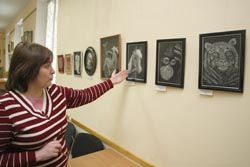Floristic designs: remedy for boredom and depression

The House of Nature is hosting the exhibit of the flat-bed florist Kateryna Kostenko and her pupils. Every Saturday master classes are held here, and the artists tell about the history of this art, revealing the secrets of gathering the materials for the future pictures. Probably, not everyone knows that the refined ornaments, landscapes, portraits, and still lifes made of dried flower petals, leaves, blades of grass, and poplar fluff, have, in addition to their high artistic value, a salubrious effect. You don’t need any pills after looking at the picture: all headaches and pains in the heart pass and the mood improves.
The flora palette is as rich as paints and pastels; pictures made of natural materials may last as long as the traditional pictures, but the material to prepare them is cheaper and more easily available.
One can use almost everything: onions and garlic peelings, fallen and dried autumn leaves, petals of different flowers, banana and apple skins, and parts of the fruit of decorative ground-cherry. The masters’ imagination knows no limits. You need a bit of imagination, diligence, and experience to create a wonderful composition. And the process itself may bring so much benefit and pleasure! At first you will promenade in the open air, gathering the materials, afterwards there will be a sort of meditation on the designs.
The art of floristry goes back to ancient Japan, just as its name, oshibana. Translated from Japanese, it means pressed flowers. Everybody knows the term of ikebana. These are three-dimensional bouquets made of live or dried plants. Oshibana is an arrangement of flowers on a plane surface. Interestingly, it was men’s job in Japan. The ornaments of dried flowers were discovered in the cultures of ancient Judea and Egypt, 5,000 to 3,000 BC; Trypillians also had them. There is an opinion that the Magi knew well the magic of the dried flowers.
Later the mystic meaning of this art was forgotten. People started to make herbariums solely for scientific or aesthetic purposes. Decorative herbaria entered the European fashion in 19th century. Decorative pictures made of dried flowers in oval frames embellished the walls of the luxury parlors of England, Germany, and France.
In 1989 in Kyiv’s House of Wildlife organized the club “Nature and Creativity,” which began to hold exhibits of Ukrainian masters’ works made of natural materials. The current exposition entitled “Nature is My Inspiration” presents pictures of different genres: landscapes (“Native Village,” “Wet Meadow,” “A Forest Path,” “A Dawn on the Lake,” and “My House”), still lifes, portraits, miniatures, and even greeting cards. A horse, monkey, tiger, cat, and other animals made of poplar fluff look true to life. Pure and bright pictures depicting the churches of Kyiv’s monasteries are inlaid with straw or ground-cherry leaves, something you can see only if you take a close look. Many colors of different plants, filigree painstaking work, recreation of moods, and the flight of imagination impress the viewers and inspire them to create.
Kostenko is a translator by profession. She took up floristry after she retired. Now she is a popular artist of decorative and applied arts. She has created hundreds of pictures and held many private exhibits in the 19 years of her artistic career. She employs different techniques and is a unrivaled master of landscapes. Her favorite material is the fruit of the decorative ground-cherry.
It is very difficult to work with fluff on velvet. This is that same poplar fluff, which floats in the air in May and June, gets in your mouth and nose, and we wait for the rain to beat it down to the ground. The fluff of other plants is also used for some pictures, for example the fluff of the milkweed fruit. Pictures made of straw are also on display.
Kostenko does not hide her creative secrets. She shares them generously with all those who are interested. Her pupils include many young people; their works are also on display. Each of them has her own material, style, manner of execution, and favorite theme.
“Never doubt whether you have time for this pastime. Wherever your destiny takes you, to barren countryside, a summer cottage, or an exotic resort, take some old books with you. Using them, you can dry everything you need for a floristic picture,” says Tetiana Berdnyk, a well-known Ukrainian florist, adding: “In winter you will have a piece of summer on your wall.”






